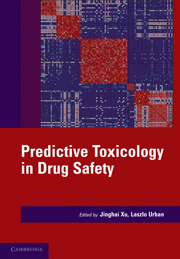Book contents
- Frontmatter
- Contents
- Contributors
- Prologue – Predictive toxicology: a new chapter in drug safety evaluation
- PREDICTIVE TOXICOLOGY IN DRUG SAFETY
- I SPECIFIC AREAS OF PREDICTIVE TOXICOLOGY
- II INTEGRATED APPROACHES OF PREDICTIVE TOXICOLOGY
- 10 Integrated approaches to lead optimization: improving the therapeutic index
- 11 Predictive toxicology approaches for small molecule oncology drugs
- 12 Mechanism-based toxicity studies for drug development
- 13 Fish embryos as alternative models for drug safety evaluation
- 14 The role of genetically modified mouse models in predictive toxicology
- 15 Toxicogenomic and pathway analysis
- 16 Drug safety biomarkers
- 17 Application of TK/PD modeling in predicting dose-limiting toxicity
- 18 Prediction of therapeutic index of antibody-based therapeutics: mathematical modeling approaches
- 19 Vaccine toxicology: nonclinical predictive strategies
- Epilogue
- Index
- Plate section
- References
15 - Toxicogenomic and pathway analysis
from II - INTEGRATED APPROACHES OF PREDICTIVE TOXICOLOGY
Published online by Cambridge University Press: 06 December 2010
- Frontmatter
- Contents
- Contributors
- Prologue – Predictive toxicology: a new chapter in drug safety evaluation
- PREDICTIVE TOXICOLOGY IN DRUG SAFETY
- I SPECIFIC AREAS OF PREDICTIVE TOXICOLOGY
- II INTEGRATED APPROACHES OF PREDICTIVE TOXICOLOGY
- 10 Integrated approaches to lead optimization: improving the therapeutic index
- 11 Predictive toxicology approaches for small molecule oncology drugs
- 12 Mechanism-based toxicity studies for drug development
- 13 Fish embryos as alternative models for drug safety evaluation
- 14 The role of genetically modified mouse models in predictive toxicology
- 15 Toxicogenomic and pathway analysis
- 16 Drug safety biomarkers
- 17 Application of TK/PD modeling in predicting dose-limiting toxicity
- 18 Prediction of therapeutic index of antibody-based therapeutics: mathematical modeling approaches
- 19 Vaccine toxicology: nonclinical predictive strategies
- Epilogue
- Index
- Plate section
- References
Summary
Toxicogenomics is the use of genomic technology for evaluating toxic potential of chemicals. It allows for large-scale study of gene expression changes associated with toxicity endpoints. While toxicogenomics brings greater access to information of chemical effects on gene expression than ever before, it presents unprecedented challenges to data analysis and interpretation, which is crucial if we want to turn the new available information into risk assessment knowledge that helps decision making.
In this chapter, we start with background information of toxicogenomics and its applications, challenges, and progress. We then focus on toxicogenomics data analysis by first highlighting the impact of study design, followed by a review of biological pathway and network, including their application to data analysis. Finally we discuss some case study by pathway approach. Even though this chapter largely focuses on transcription-based technologies, the study of toxicogenomics covers a far broader scope, including proteomics, metabonomics, and, by a broad definition, pharmacogenetics that links underlying genetics to different susceptibilities to toxicants. Indeed, an integral analysis of toxicity often calls for incorporating other ‘Omics such as proteomics and metabonomics.
INTRODUCTION TO TOXICOGENOMICS
With the advance of genome sequencing and availability of chip technology in the late 1990s, study of the genome-wide effect of toxicants become possible. Spawning the field of toxicogenomics is a drive from applied genomics. Whereas it began with cDNA arrays custom designed for toxicology, commercial whole genome chip for toxicologically important species such as rat, mouse, or dog soon become available and is being used in a variety of toxicogenomics studies.
- Type
- Chapter
- Information
- Predictive Toxicology in Drug Safety , pp. 284 - 301Publisher: Cambridge University PressPrint publication year: 2010



